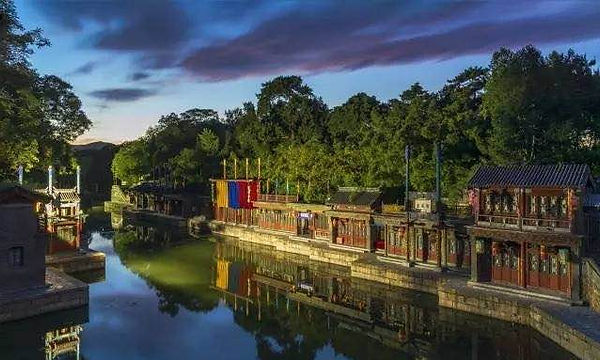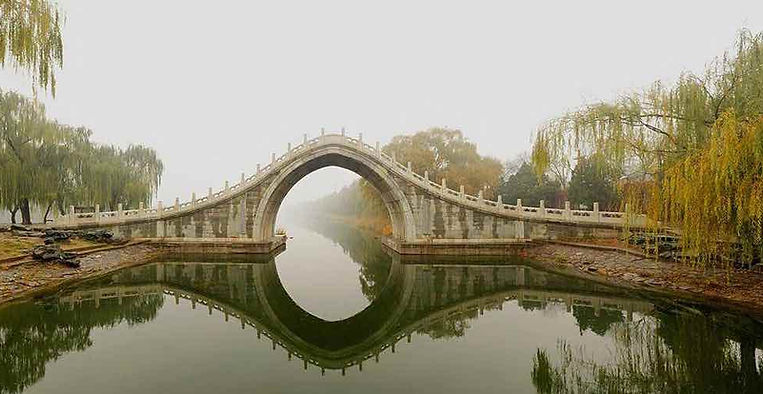The Summer Palace — Imperial Garden of Perfect Combination of Natural Landscape and Artificial Buildings
The Summer Palace, also named Yihe Yuan in Beijing, was an imperial garden during the middle to late Qing Dynasty (1636 — 1912).
Today, it stands as a well-preserved masterpiece of the traditional Chinese imperial garden and is recognized as one of the UNESCO World Heritage Sites.
The palace combines beautiful natural landscapes, extraordinary building complexes, and relics with significant cultural value.

Tower of Buddhist Incense (or Foxiang Ge) and Other Building Complex on Front Hill of Longevity Mountain or Wan Shou Shan, Next to Kunming Lake.
Difference Between Old Summer Palace and Summer Palace
The Old Summer Palace, also known as Yuanming Yuan, covers an area of 3.5 square kilometers.
It was constructed in 1707 as a gift from the Kangxi Emperor to his fourth son, who later expanded the garden after ascending to the throne as the Yongzheng Emperor.
Part of Court Painting "Forty Scenes of the Old Summer Palace" (Yuan Ming Yuan Si Shi Jing Tu Yong), by Artist Tang Dai and Shen Yuan in the Year 1744 — Bibliothèque Nationale de France
The Summer Palace, also known as Yihe Yuan, spans 2.9 square kilometers and was constructed in 1750 under the orders of the Qianlong Emperor as a gift for his mother's 60th birthday.
In 1860, both of these magnificent gardens fell victim to robbery and arson by the Anglo-French Allied Forces during the Second Opium War.
Several decades later, only the Summer Palace was reconstructed under the command of the Guangxu Emperor.

Ruins of the Old Summer Palace
History and Development of the Summer Palace
During the Yuan and Ming Dynasties, the area where the Summer Palace was located had been developed.
Some emperors of Ming, such as Zhengde and Wanli, built temporary palaces and spent vacations there.
In 1750, Emperor Qianlong commanded to build a grand imperial garden as a birthday gift to his mother, completed in 1764.
In 1860, the Summer Palace, together with other fabulous royal gardens, was burned down and robbed by the Anglo-French Allied Forces.
From 1884 to 1895, the Summer Palace was rebuilt under the command of the Guangxu Emperor as the retirement residence for Empress Dowager Cixi.

Painting of Empress Dowager Cixi, By Hubert Vos in 1905 — Beijing Summer Palace
In 1900, the garden was destroyed again by the Eight-Nation Alliance, and two years later was renovated by the Qing government.
However, many buildings and decorations were reduced and downsized because of financial issues.
Later, the Qing Dynasty ended in 1912, and this former imperial garden started to sell tickets and opened to the public in 1914.

Tower of Buddhist Incense or Foxiang Ge and Hall of Dispelling Clouds or Paiyun Dian and other Building Complex of Summer Palace.
Structural Designs of the Summer Palace Based on Legends
The Summer Palace mainly includes a big lake, three islands, a tall hill, and thousands of exquisite buildings.
Kunming Lake
Great Emperor Wu of Han (156 BC — 87 BC) used to dig a lake named Kunming to train his navy.
Therefore, Emperor Qianlong named this lake Kunming as well, wishing to obtain exceptional military achievements.
Three Islands
In ancient Chinese Mythology, there are Three Mythical Mountains on the sea, named Penglai, Fangzhang, and Yingzhou, on which many deities live.
Therefore, starting with Qin Shi Huang (259 BC — 210 BC), emperors would construct three islands in large lakes within their royal palaces to emulate this wonderland.

Seventeen Arches Bridge to Nanhu Island, One of the Three Islands on the Kunming Lake.
Longevity Hill
Since this garden was built for the Qianlong Emperor's mother, he named the main mountain "longevity" as a beautiful wish.

Longevity Hill and Kunming Lake of the Beijing Summer Palace
Special Scenic Views of the Summer Palace
Long Corridor
Along Kunming Lake, there is the world's longest corridor.
It is a 728-meter-long covered promenade with 273 sections and decorated with over 14,000 exquisite paintings, including historical stories, legends, landscapes, plants, etc.

Part of the Long Corridor, Chang Lang, of the Summer Palace.
Palaces for Royals to Work, Live, and Temples to Pray.

Bronze Statues and Flowers in Front of Hall of Benevolence and Longevity or Renshou Dian, An Important Administrative Building Complex of the Late Qing, Photo from Miaoxishuibuxing.
Baoyun Pavilion, the Biggest (7.5 meters tall) Existing Copper-made Pavilion in China.
.jpg)
Copper Made Baoyun Ge, the Black Pavilion in the Middle.
Suzhou Market Street
A royal commercial street imitated the southern style of Suzhou City, where the shop assistants were mainly imperial maids and eunuchs.

West Embankment of the Summer Palace

Jade Belt Bridge

Marble Boat

Photos are from the Official Site of the Summer Palace.
You Might Also Like:
Chinese Gardens — Aesthetics, Philosophy, and Architecture in Nature
Chinese Palaces — Architecture and Art of Imperial Feats
Chinese Emperors — Ultimate Introduction to Emperors of Ancient China
Empresses of China — Ultimate Introduction to Imperial Harems of Ancient China
Cultural Symbol Across Time and Space — Yellow River or Huang He River
Longest River of China — Yangtze River or Chang Jiang River
Historic Military Defense System and Cultural Icon — The Great Wall of China
Guarding Warriors of the Mausoleum of the First Qin Emperor — Terracotta Army
Ancient Trade Routes That Connected the East and West — Silk Road
Imperial Sacrificial Building Complex of Ming and Qing — Temple of Heaven
The Largest Existing Imperial Palace and Witness of History — Forbidden City
Royal Mountain Resort In Picturesque Natural Views — Chengde
Artful Southern Style Classic Garden — Humble Administrator Garden
Magnificent Buddhism Palace on Tibetan Plateau — Potala Palace
Classical Southern Garden of Borrowed Sceneries — Lingering Garden
Temple — Religion, Culture, and Art Across Time
Pagodas that Trying to Reach the Sky — Origin, History, and Facts
List of Exceptional Chinese Pagodas
Exceptional Buddhist Art Gallery on Silk Road — Mogao Grottoes
Localization and Secularization of Buddhist Cave Art — Yungang Grottoes
Royal Stone Carving Museums on Cliff — Longmen Grottoes
Cultural Meanings of Extraordinary Attractions in China
Legend, History, and Culture of Chinese Lakes
History and Culture of Magnificent Mountains in China










